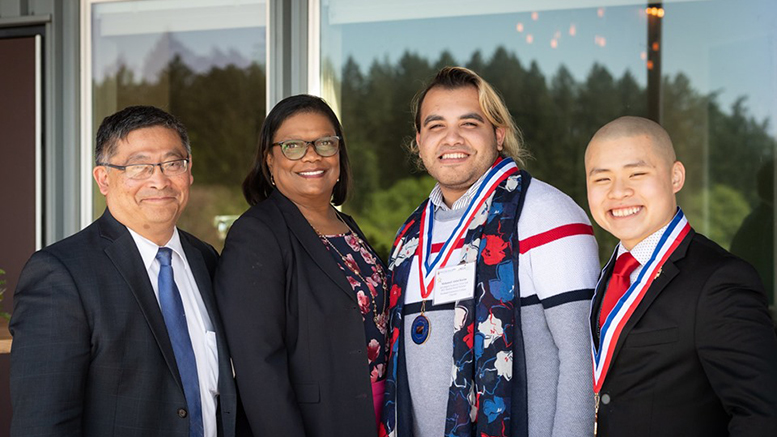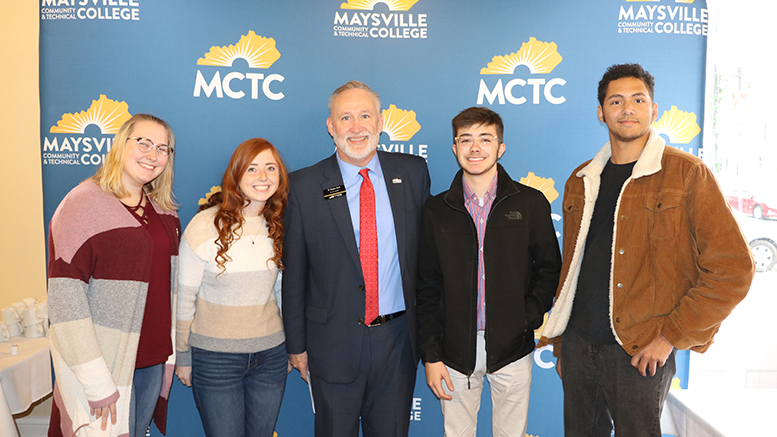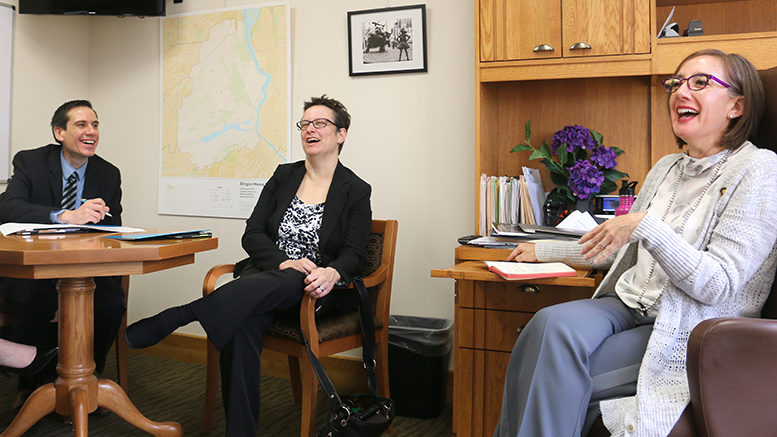Making the transition from being president of one community college to another is challenging enough. Doing it during a pandemic, when meetings have to be conducted virtually, is another level.
After Lisa Avery, president of the Sylvania Campus at Portland Community College, was hired March 3 as the new president of Linn-Benton Community College (LBCC), also in Oregon, she was able to visit her new campus and meet the board before both campuses closed.
But then, when all meetings became virtual, “they were more targeted and had very specific, focused agendas on key elements of the presidential transition,” Avery says. One of her biggest challenges, however, is the lack of face-to-face community outreach.
Avery, a member of the American Association of Community Colleges (AACC) board of directors, says the transition was made somewhat smoother by that fact that she is succeeding Linn-Benton’s current president, Greg Hamann, who is retiring and who just completed a term on the AACC board.
“Passing the baton from Greg to me has been a virtual experience, but also has been a more conscious and a more focused experience,” Avery says. He made introductions to key college leaders on Zoom meetings, which traditionally would have been done over a cup of coffee.

“We’re trying to make sure there is continuity of operations,” which is especially important when there’s a leadership transition during a crisis, Avery says.
The crisis, in this case, is a financial one, due to state funding cuts, and that means Avery is spending more time talking to colleagues at the Oregon Community College Association. It’s also critical to “stay focused on the college’s mission,” she says. “Low-wage dislocated workers need us to be ready for them even more than before.”
As a member of the AACC board, Avery has participated in weekly Zoom meetings with AACC President Walter Bumphus, and “that has been a tremendous help. It’s giving us a national perspective. It’s good to have strength in numbers.”
Handling enrollment
When Avery starts at LBCC on July 1, the biggest unknown is what fall enrollment will look like, she says. The pattern after several recessions has shown unemployed adults returning to college, she says, but the impact of COVID-19 on enrollment is more uncertain. Training needs for various industries are also hard to predict.
“Finding the sweet spot in how to manage changing enrollment will be a challenge for fall,” Avery says. “Linn Benton made some great contingency plans to add more courses, if needed.”
While it’s a challenging time for any college to make a presidential transition, it’s also a time for community colleges to play a key role in helping their communities get back on their feet through higher education, Avery says.
“The privilege for me as LBCC’s new president is that I am starting at a time when that message is more important than ever – as is building partnerships with our business and community leaders to come up with new and creative paths forward,” she says.
An opportunity for innovation
“All of the things we know are important for developing relationships usually happen on solid ground,” says Karin Edwards, president of the Cascade Campus at Portland Community College, who in February was hired as president of Clark College in Washington state.
“It’s critically important to get to know and understand the culture of the institution, to get to know people and develop relationships, spend time with students and spend time in the community,” Edwards says.
But since the virus took hold, she has been meeting the Clark College board of trustees, members of the college foundation’s board and other key personnel on Zoom.

“The hard part is I really wanted to get in there and have a presence and show people we are going to work through this and do this together,” Edwards says. With Zoom, “you don’t get all the nuances and all the emotions you get in an in-person conversation.”
Clark already went through significant budget reductions and might have to do another round, which could result in layoffs and benefit cuts, Edwards says, adding: “There is a lot of pain, anger and disappointment associated with that.”
After she starts the new position in July, she hopes to increase marketing of the college to people who’ve lost their jobs or want to upgrade their skills, and to parents hesitant to send their kids to a college out of town.
“We have to show parents the community college is an excellent way to stay sharp with academic skills,” she says.
Figuring the numbers
Having a “crazy increase in enrollment” is not necessarily the goal, Edwards says. The best strategy is to determine the optimal number of students for the college and to serve them appropriately, she says.
“We’ve been talking about what a challenge this is going to be. But it’s also a pivotal moment,” Edwards says. “We can determine the future of higher education. There are things we can do better. This is an opportunity to be innovative.”
It’s also an opportunity to address inequities for the future, Edwards says. As higher education becomes increasingly multimodal, “we have to make sure nobody gets left behind,” she says.
The student perspective
John Gossett, who was hired as president of Asheville-Buncombe Technical Community College (AB Tech) in North Carolina in mid-April, was able to complete all the interviews in the traditional face-to-face format before the pandemic took hold and college campuses shut down.
Gossett is already familiar with the community, as McDowell Technical Community College, where he has served as president for the past three-and-a-half years, is in the adjoining county.
Gossett had already known the AB Tech leadership team through various state higher education associations, so it’s not a completely new environment. He is less familiar with county commissioners, civic and neighborhood leaders and employers, so getting to know them will be a priority after he starts on July 1.
McDowell Tech had extensive experience with distance learning, so it was able to make the switch to all online courses in a week and a-half, Gossett says. He plans to bring that experience to AB Tech, where he hopes to offer more support for faculty to provide a richer classroom learning environment.
Gossett also intends to plan for the worst-case scenario – if campuses open in the fall but a COVID-19 surge hits and they need to close again. “At least we’ll be better prepared if that happens,” he says.
One silver lining during the pandemic is that it has allowed some leaders to review operations and procedures at their colleges. Taking the helm at another college also provides that opportunity, Gossett said.
Focus on listening
Katrina VanderWoude started as president of Los Angeles Trade Technical College in February, just a few weeks before the Los Angeles Community College District shut down campuses at all nine of its colleges.
“I was just starting to have get-to-know-you meetings with constituency groups and employee groups, and all of sudden, that was gone,” says VanderWoude, who previously was president of Contra Costa College in northern California.
Since then, “we’re all living on Zoom,” she says. There are some advantages to that, though: Participating in so many online meetings put her in contact with colleagues she might not have met for months.
“When you’re in the same room – in a classroom or a meeting – a few people speak more than others. In a Zoom meeting, everyone is on an equal footing,” VanderWoude says.
VanderWoude feels fortunate being a part of the Los Angeles Community College District and having eight peer presidents to work with. And as the colleges look toward the recovery process, she says, it’s good to remember, “no matter how bad this is, it’s temporary.”
A sense of consistency
Stephen Vacik, who starts as president of Hinds Community College in Mississippi on July 1, says, ordinarily he would be turning over more of what’s going on at his current college and preparing for the transition. But the crisis has required him to keep his hands on the helm.
Vacik, currently president of Maysville Community and Technical College in Kentucky, previously served as president of Colby Community College in Kansas.
At Maysville, “we’re at a place where employees, students and the public need a sense of consistency. That’s my charge, to help maintain that,” he says.

So instead of turning over much of the work to the interim president, Russ Ward, the chief operations officer at Maysville, Vacik is enmeshed in next year’s budget, the plans for reopening, and figuring out “how to bring people back safely and maintain public health.”
At the same time, Vacik is familiarizing himself with the issues at Hinds. He’s read through the college’s strategic plan, previous budgets and enrollment management plans.
“The reality is, you’d like to sit down and take a broad look at all that and on day one, know which areas we are strong in and where we need more work,” he says. “I haven’t had time to take a deep dive. It’s going to be a firehose.”
Unlike Maysville, Hinds Community College has residence halls, so that adds another layer to the strategy for reopening the campus.
Vacik also needs to consider what to do about instructional delivery.
“We want to try to operate as normally as we can. But we need to have contingencies in case we have to jump back to online instruction or have more hybrid courses,” he says.
Planning for July
By the time Vacik officially starts at Hinds next month, he will be able to have face-to-face meetings. One of his top priorities on the job is getting to know local employers and ask them about their training needs.
When the pandemic is over, he expects many small businesses will have permanently closed, and many unemployed individuals will look for new careers or seek to upgrade their skills.
With a flat budget projected, Vacik says, “we need to be very intentional in where we put our resources. We need to look at all our programs and see whether some might need to be ramped up.”
“Community colleges usually get the least amount of state funding, while we serve the most students,” he says. “This is a good time for all community colleges to take a deep dive into whether we are being good stewards. How can we best use what we have to serve our students?”

